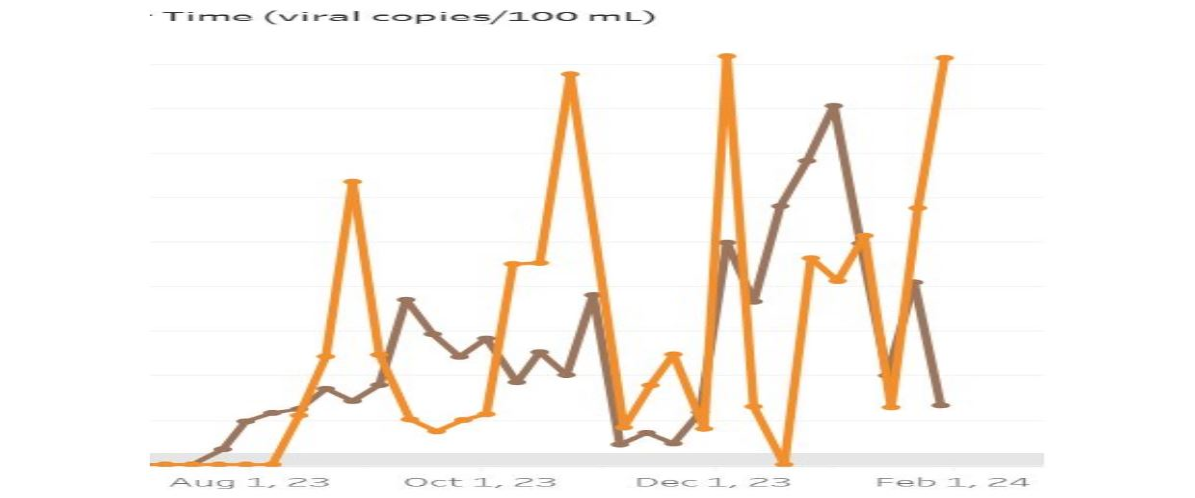A Graphical Perspective
For those of you into graphs, Biobot has a new Year-Over-Year option, with 2024 being in orange. You can see that the orange curve is pretty flat over the last few weeks, and is closely following last year’s curve (lime green). If we continue on this path, we’ll be at low levels of the virus for a few months. Enjoy!
A Mathematical Perspective
Last time, we shared calculations that about one of every 100 people is currently contagious with covid-19. In the Northeast, this hasn’t changed much. In the rest of the country, it’s dropped lower — now more like one of every 200 people.
Let’s use the Northeast for an example, and expand the math. If you are having a haircut with one barber and you two are the only ones there, clearly there is a 1% chance that the barber is currently contagious. If you are having a bridge party with two tables, the odds are 8% that one or more of the eight of you are contagious. With 100 people in your grocery store, there is a 63% chance at least one person is contagious. And with 450 people or more, the odds are at least 99%.
Given this information, you can adjust your covid safety practices to suit.
A Ventilation Perspective
As you know, great fresh air ventilation can cut your risk of covid-19 and other airborne diseases by 80% or more! Yet, this convenient remedy (no vaccinations or masks required!) is almost universally ignored. If you had a choice of stores for your shopping, would you favor one with a big sign on the door that said
Welcome — Come In To
Certified and Monitored
HEALTHY FRESH AIR
and had a nice picture on the door, and a big bold meter inside showing off the “green zone” fresh air?
There are some important voices joining in this message. Here is a sampling:
- Some truth from the World Health Organization: They assembled fifty experts and produced a document recognizing the obvious — that most respiratory infections, including Covid-19, influenza and measles, are spread by aerosols that stay suspended in the air for hours, and NOT by large droplets that magically fall to the ground and don’t infect persons more that three feet away. For readers of this blog, this is not news (see Mar. 21st, 2022 blog post). “The change puts fresh emphasis on the need to improve ventilation indoors.” Now the question is whether the CDC and the rest of America will follow suit.
https://www.nbcnews.com/health/health-news/who-airborne-disease-cdc-updated-guidelines-rcna149843
- Canada is taking good air quality seriously. Here is an excellent article directed toward schools. It includes quotes from numerous experts. Epidemiologist Colin Furness said
“It won’t be cheap to improve ventilation in thousands of classrooms. But even if you don’t think protecting kids is important, you should still get behind this from a dollars and cents perspective. Consider the difference in cost between disease prevention and disease treatment. When some kids get COVID or the flu at school and come home, grandpa and grandma end up in the intensive care unit. A couple of stays in the ICU might pay for all the ventilation upgrades needed for a school.”
And he is on board with letting people know about the air quality.
“Dangerous air isn’t noticeable. Politicians, like everyone else, need to be able to see a problem to be motivated to do something about it. To help us get there, I would like to see mandated air quality sensors in public rooms and spaces. That way people could see when they board a train or bus, or go into an office or a classroom, what the air quality is actually like. If we want to have a serious conversation about air quality, we need to bring people to a certain level of literacy and awareness. To solve invisible problems, you really gotta make them visible first.”
https://healthydebate.ca/2023/11/topic/structures-are-sick-clean-air-schools/
- In the US, on CBS, 60 Minutes had a segment on ventilation in October of last year. They interviewed people who had suffered from poor ventilation, as well as several experts, including Harvard’s Joe Allen, who said
“Think about the public health gains we've made over the past hundred years. We've made improvements to water quality, outdoor air pollution, our food safety, we've made improvements to sanitation: absolute basics of public health. Where has indoor air been in that conversation? It's totally forgotten about. And the pandemic showed what a glaring mistake that was.”
https://www.cbsnews.com/news/indoor-air-quality-healthy-buildings-60-minutes-transcript/
Now You Can Search This Blog!
We have added a “search” bar for this blog - scroll all the way down
to the very bottom of a blog page to find the search bar.
When using the “search” bar, please, if at first you don’t succeed, try, try again!
[The website company has an ongoing glitch.]
Find all of the blog post titles on our “Resources” page on the website:
Comprehensive List of Blog Postings (PDF).



















